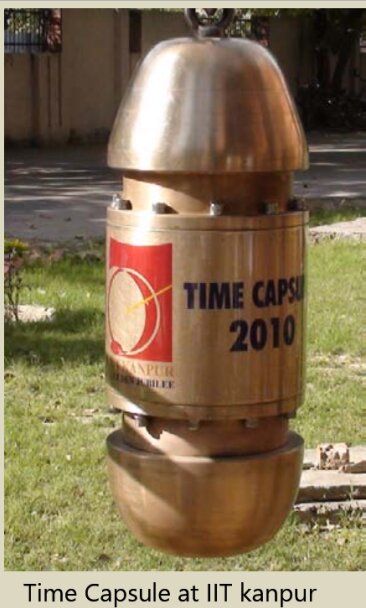Science & Technology
Time Capsules
- 04 Aug 2020
- 4 min read
Why in News
The Ram Janmabhoomi Teerth Kshetra Trust has denied reports about placing of a time capsule under the ground at Ram Temple construction site in Ayodhya.
- The Time Capsule, also known as Kaal Patra, was supposed to contain the history of Ayodhya and Rama Janma Bhoomi Movement.
Key Points
- Time Capsule is a container of any size or shape, which accommodates documents, photos and artefacts typical of the current era and is buried underground, for future generations to unearth.
- To ensure that the capsules do not decay they are built using special engineering techniques like steel or aluminium encasing, vacuuming, use of acid-free paper, etc.
- The time capsules mostly have a scheduled time for reopening, and are supposed to be buried again after opening, with people of the future adding their own contributions to the time capsule.
- The International Time Capsule Society (ITCS), based in the USA and formed in 1990, is now defunct but continues estimating the number of time capsules in the world.
- As per its database, there are 10,000-15,000 times capsules worldwide.
Famous Time Capsules in the World
- Samuel Adams and Paul Revere Time Capsule: It is the oldest known time capsule from 1795 (USA).
- The “Century Safe": The world’s first planned time capsule was established at Philadelphia Centennial Exposition (USA) in 1876. It was opened and resealed in 1976.
- The Crypt of Civilization in Georgia: It was built around 1940 at Oglethorpe University in Brookhaven, Georgia and is scheduled for opening in the year 8113 AD. It is a project to preserve all human knowledge and was the brainchild of Thornwell Jacobs, also known as father of time capsules.
- The Voyager and Voyager II Spacecraft: They are currently circling on the edge of our solar system. These capsules were created by NASA to be seen by future generations.
Time Capsules In India
- Outside the Red Fort: This was placed underground in 1972 by the then Prime Minister Indira Gandhi, was dug out by the subsequent government in 1977. It raised a controversy as it was said to glorify Gandhi Nehru family in indian History.
- At IIT Kanpur Campus: This time capsule was buried on 6th March, 2010 containing details on IIT Kanpur in the form of documents, photographs, and films.
- At The Alexandra Girls’ English Institution, Mumbai: It was set up in the 19th century and is scheduled to be opened in 2062. It contains information on the school.
- At Jalandhar’s Lovely Public University: It was buried in January 2019 and contains 100 items that represent modern-day technology in India.
Significance
- Time Capsules are intended as a method of communication with future people.
- They are also supposed to help future archaeologists, anthropologists, or historians in knowing about the past human civilisation.
Criticism
- Most intentional time capsules are filled with a lopsided view of history. They are often politically motivated and glorify the people who planted them.
- They can not be regarded as facts and are not very reliable. The information in time capsules has to be verified with other sources of information.
- Many time capsules which have been unearthed were filled with junk telling little about the people of the time.




